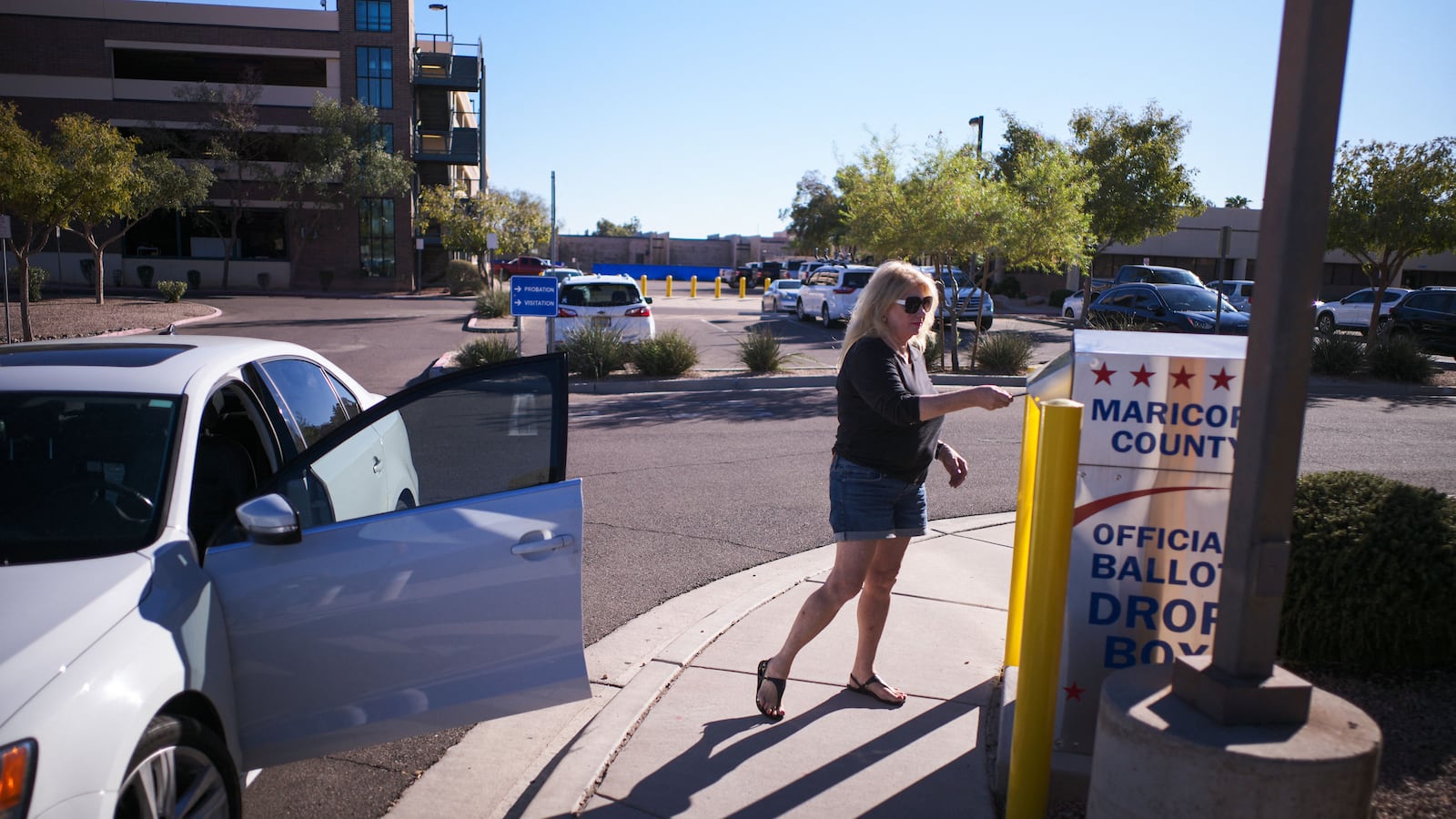The movement to try to catch illegal voting at ballot drop boxes in Arizona, which is spurring complaints and lawsuits alleging voter intimidation, is not the local grassroots effort it appears to be.
The drop box watchers are part of a coordinated fast-growing national effort with thousands of volunteers who say they want to help try to collect evidence of people illegally depositing others’ ballots during the midterm election, according to a Votebeat review of internal discussions among group organizers, internal contact lists, and posts and videos on right-wing media sites.
One group behind it all: True the Vote, the Texas-based nonprofit organization that has repeatedly promoted debunked conspiracy theories about election fraud via drop boxes. True the Vote created the “2000 Mules” movie claiming widespread “ballot harvesting” at drop boxes, without offering evidence to back up the claims. This new project appears to be an attempt to gather the evidence missing from their first try.
“This is the greatest opportunity for us to catch the cheaters in real time maybe that’s ever existed,” True the Vote’s Gregg Phillips said on a video posted on Rumble.com a few weeks before early voting began in Arizona. “So we’re excited about it.”
Representatives of True the Vote and Clean Elections USA have openly talked about their partnership on videos posted online and other communications aimed at supporters, but True the Vote’s involvement has drawn little notice outside of that.
With early voting underway for the Nov. 8 election, more than 4,500 people have signed up across the country to monitor drop boxes or help otherwise with the effort calling itself Clean Elections USA, which is then feeding photos, videos and information to True the Vote. For its part, True the Vote has said it plans to give that information to local sheriffs through an organization founded by Pinal County Sheriff Mark Lamb, according to the videos and discussions reviewed by Votebeat.
Organizers in Arizona have exchanged dozens of messages on an online forum, a central hub for the effort where they are training watchers on how to report activity, discussing the legality of their own actions, and forming groups by zip code to watch over certain drop boxes. Votebeat filled out a form on the group’s website and was granted access to the discussion board. Their list of volunteers is growing by dozens a day, especially since the news of voter intimidation at the sites began to spread, according to a national contact list Votebeat reviewed.
“We did this for primaries alone, we can do this again,” someone using the username “Kelly Az” wrote on the discussion board in August. “This is the most important election yet.”
On the forum, the founder of Clean Elections USA, Melody Jennings, urges volunteers not to engage voters and to stay at least 75 feet away from the drop box, the distance state law requires for those engaged in electioneering. Another organizer has posted maps showing the 75-foot radius at the outdoor drop boxes at the Maricopa County Juvenile Court in Mesa and county elections center in downtown Phoenix, where the largest groups of volunteers have been gathering.
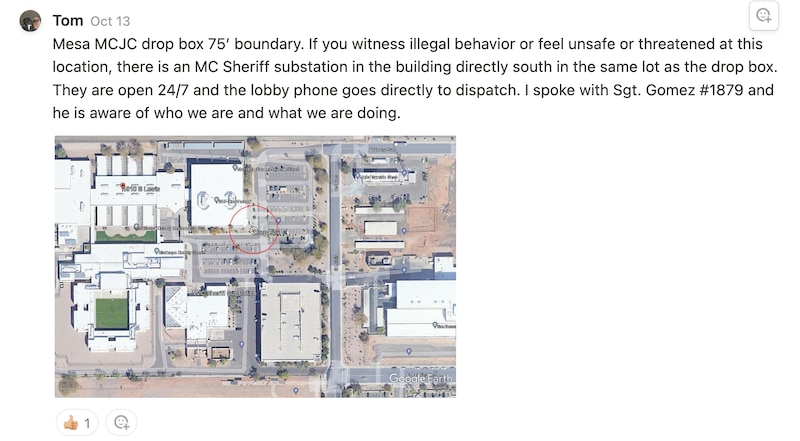
But voters at those locations reported feeling intimidated by people watching them at the drop boxes, taking photos and videos of them and photos of their license plates. In the last week, the Arizona secretary of state’s office reported five complaints to the FBI and the state attorney general’s office, and nine other complaints are under review. A few of those voters claim they have been harassed by groups watching the drop boxes. An ABC15 reporter interviewed one of the watchers and he said the watchers were with Clean Elections USA, although Clean Elections USA has said its members were not involved with any cases of voter intimidation.
One voter told the secretary of state’s office that the group was filming and photographing him and his wife, and “accusing us of being a mule.”
“They took photographs of our license plate and of us and then followed us out of the parking lot in one of their cars continuing to film,” the voter reported.
Three voting rights groups — the Arizona Alliance for Retired Americans, Voto Latino and the League of Women Voters of Arizona — have filed two separate federal lawsuits alleging voter intimidation. The lawsuits do not name True the Vote. This is a “textbook example” of voter intimidation, in which the voters are threatened by baseless allegations that they are committing voter fraud just by casting their ballot, said Jared Davidson, a lawyer for Protect Democracy representing the League.
“Any reasonable voter would be scared to deposit their ballots,” Davidson said. The groups are asking the courts to immediately block drop box monitoring for the rest of the election.
The allegations against the group are false, Jennings insisted in an emailed response to a request for comment Thursday. “All activities supported by Clean Elections USA are lawful and designed to support lawful elections,” she wrote. “We look forward to defending against this partisan effort to undermine election monitoring.” Jennings declined to talk further or respond to specific questions.
A federal judge has said he will rule by Friday in one of the cases. Another group named in one of the suits, the Lions of Liberty, that had said it was organizing people to watch drop boxes in Yavapai County reportedly ordered its volunteers to “stand down.”
Trying to gather evidence that someone is voting illegally using a drop box is futile, Davidson said. Dropping off others’ ballots is legal in Arizona in many circumstances. You can drop off a ballot for a family member, roommate, or someone you care for. Even if the watchers see someone with more than one ballot, there is no way the watchers can tell whose ballots they are casting, Davidson said, or whether they are entitled to do so.
True the Vote didn’t acknowledge that dropping off more than one ballot is legal in Arizona in “2000 Mules,” instead classifying someone as a “mule,” or “ballot harvester” if they dropped off a certain number of ballots. They claimed there were more than 200 “mules” in the state, but offered no video or other evidence showing people dropping off more than one ballot. There were no confirmed cases of ballot harvesting using drop boxes in Arizona in 2020.
True the Vote and Lamb did not respond to requests for comment.
Part of the mission, along with attempting to “catch the cheaters” is to “deter people from committing voter fraud” by collecting others’ ballots in the first place, according to a Clean Elections USA flyer posted by Jennings on Truth Social, because voters know people will be watching the drop boxes. But people can mail ballots in from any mailbox in the U.S., so it’s unclear why the backers of the group think drop box surveillance would defeat such an effort.
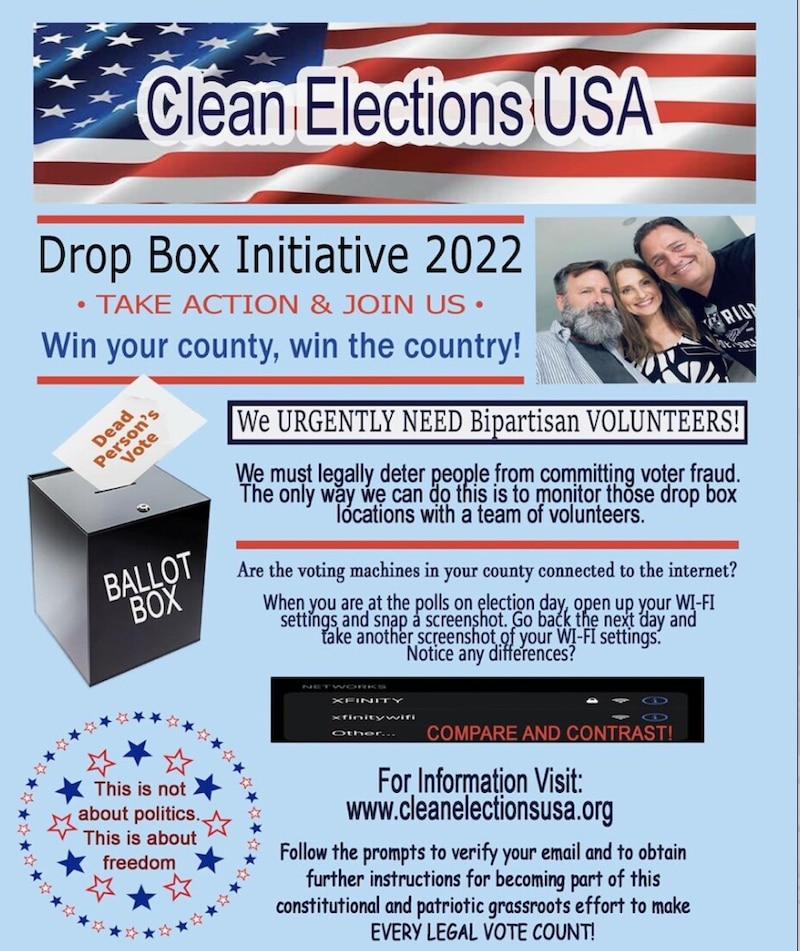
Nonetheless, Jennings told Steve Bannon on a video posted to Rumble.com this month that taking photos and videos of voters is “key to getting the ‘mules’ to stop.”
“That’s the only way the mules want to say ‘hmmm, I don’t want to be doxxed,’ and they will go away into the dark. But even if they don’t, we’ve got their picture.”
Voters who do feel threatened by the monitoring have other options. There are more than a dozen indoor drop boxes at city halls and other locations across the county, voters can drop their ballot sealed and signed at any early voting location, mail their ballot, or they can wait until Election Day to vote in person at a polling place.
Maricopa County Sheriff Paul Penzone said this week at a news conference that his deputies will be “babysitting” the drop boxes, if that is what it takes to ensure voters feel safe. County Supervisors Chairman Bill Gates said at a separate news conference that the county is focused on “protecting every single citizen’s right to vote” using whatever method they want, including drop boxes.
But this effort is not limited to Maricopa County, or Arizona. Jennings told Bannon that their efforts are focused on Arizona, Colorado, Connecticut, Michigan, Ohio, and Pennsylvania.
Asked to comment on the voter intimidation cases at a news conference this week, U.S. Attorney General Merrick Garland said the Justice Department “has an obligation to guarantee a free and fair vote by everyone who is qualified to vote, and will not permit voters to be intimidated.”
“2000 Mules” Creators’ Plan to “Catch the Cheaters”
The multi-layered plan to report “ballot harvesters” to law enforcement took shape at an August event in Arizona that True the Vote coordinated, Phillips said in the Sept. 30 video posted to Rumble.com. The event enticed viewers with a promise to release data proving its “2000 Mules” claims, but instead mainly hyped new projects and technology.
Phillips told attendees that True the Vote would be “transforming data into real-time intelligence through communication.” He said vaguely that technology would be used to “identify problems as they are happening in voting,” and said Jennings was involved.
“Our friend Melody is here, she is putting a bunch of people together that are out there looking at these drop boxes,” he said.
Jennings told Bannon and Phillips that she was inspired to get involved by “2000 Mules” and discussions on Truth Social, a social media network founded by Donald Trump. When she found herself with free time, she said, she wanted to do something to “keep those mules from wanting to come up to those boxes.” Jennings may live in Oklahoma, according to a court filing.
True the Vote has a partnership with Protect America Now, a sheriffs’ organization created by Lamb, the Pinal County sheriff. The groups’ partnership, as explained on protectamerica.vote, aims to “provide local Sheriffs with the training, resources and tools to have real-time eyes on voting in their county.” Sixty-eight sheriffs have signed on, according to the organization’s website.
About two weeks before early voting began in Arizona, on the Sept. 30 video posted on Rumble.com, Phillips and Jennings spoke in more detail about how the system would work.
First, Clean Elections USA would organize the sign-up for drop box watchers and train the volunteers to feed their photos, videos, and information to True the Vote. Jennings spoke of the importance of taking clear photos.
“These people, again, don’t want to be doxxed, they don’t want to be found out.”
True the Vote would then compile that information, enriching it with what Phillips referred to as “geotracking” data and “a little open-source intelligence” to find out “who some of these people were, maybe where did they come from, where did they get these ballots from.” He called this combination True the Vote’s “secret sauce.”
True the Vote would then send the “completed package” to local sheriffs, through Protect America Now. “Being able to hand off a completed package to a sheriff while something’s happening or during the voting rather than two years later, as we’re working on now, is critically important,” Phillips said. Phillips promised that the evidence would be “actionable.”
From there, sheriffs “can and will investigate if laws are being broken,” Lamb said in a video posted on the partnership’s website. “Look, folks, this is not complicated,” Lamb said. “These voting laws should be followed and if they are not there should be consequences.”
Jennings and Phillips both stressed the importance of providing the photos, video and information to True the Vote in “real-time” so that they could stop illegal voting in action.
Internal Discussion Shows Coordination in Maricopa County
Two Republican candidates for statewide office, gubernatorial candidate Kari Lake and secretary of state candidate Mark Finchem, have encouraged the push to watch drop boxes.
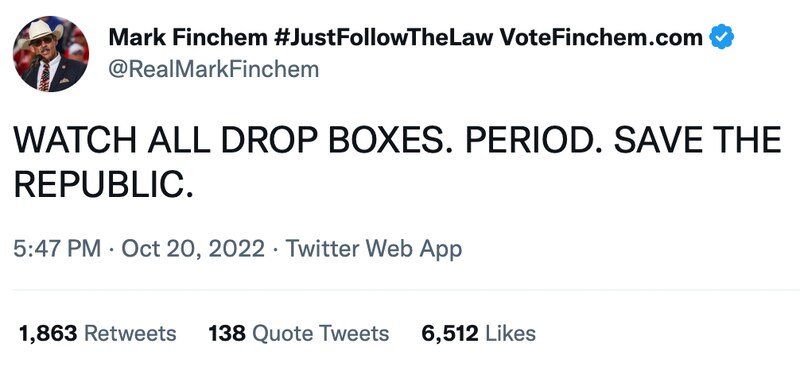
In June, Lake ran a poll asking people if they would be “willing to take a shift watching a drop box to catch potential Ballot Mules in the 2022 Election.” In July, Lake tweeted out a photo of a drop box in Coconino County and said “Potential Mules beware: we are watching drop boxes throughout the state. Smile… you might be on camera!” On Oct. 20, after voter intimidation complaints began to roll in, Finchem tweeted, “WATCH ALL DROP BOXES. PERIOD. SAVE THE REPUBLIC.”
Volunteers for Clean Elections USA began discussing their plan to monitor drop boxes in Arizona on the online forum on August 10.
Two days after early voting began, on Oct. 14, Jennings asked volunteers to go to the drop box near them and take photos of the drop box and the surroundings.
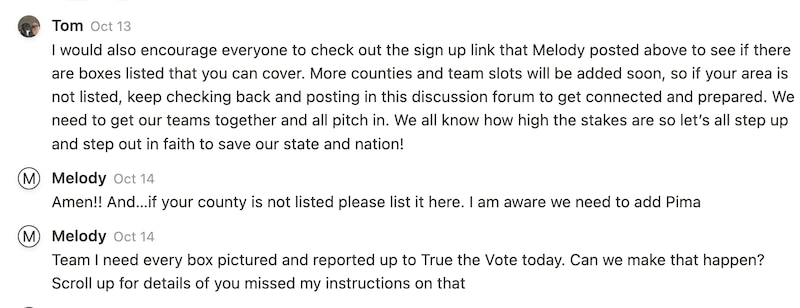
“These will go to True the Vote and will help the operational security team to have a good location map for when reports of shenanigans start coming in,” Jennings said.
The volunteers use the forum to talk about drop box locations and hours, discuss state laws, and send out sign-up links. Much of the site-specific organizing appears to happen off the forum, on private email chains organized by zip code.
On the site, volunteers are asked to watch an orientation video and there have been at least three zoom trainings. On a discussion board, Jennings once again outlined a key takeaway: Volunteers quickly need to report their photos and information to True the Vote.
“Each individual needs to send in a report to the Opsec group link below (this is Gregg Phillips Grotracking team[sic]),” Jennings wrote. “In the report type in the address and tell them in the report that you are with Clean Elections. They will record your number as being one of us so that when you do post up at a box or go about your life on the day to day they will distinguish your number as white hat good guys and won’t track your phone. It will make it easier to ascertain the mules when they start doing their thing.”
On Oct. 23, True the Vote urged people to sign up to watch drop boxes via Clean Elections USA’s website.
One of the most active volunteers on the site, who goes by “Tom,” has been organizing meet-ups at the outdoor Mesa drop box, near Maricopa County Juvenile Court, a location linked to three of the voter intimidation complaints that have been referred.
Early in the morning the day after ballots were mailed out, he posted “12:55 AM All quiet at MCJC so far.”
The same day, he encouraged more action. “We need to get our teams together and all pitch in,” he wrote. “We all know how high the stakes are so let’s all step up and step out in faith to save our state and nation!”
A week later, he wrote that the “mule activity has been slow so far and I think we have them nervous cause they never know for sure if we are watching.”
Jennings told Bannon on Oct. 15 that 1,500 volunteers had signed up to help.
That number of volunteers would begin to skyrocket after claims of voter intimidation started making the news over the next week. During the week of Oct. 17, dozens were signing up across the country every day. By Oct. 20, the latest activity visible, more than 4,500 people had signed up, including residents of nearly every state. Of those, about 3,200 said they were interested in monitoring drop boxes, while the rest said they could help with tasks such as organizing, recruiting, research or security. More than 100 volunteers signed up by Oct. 20 in each of Arizona, California, Colorado, Connecticut, Florida, Georgia, Illinois, New York, North Carolina, Michigan, Ohio, Pennsylvania, Texas and Washington, with the largest number, 445, in Arizona.
Judge to Decide Whether Monitoring Amounts to Voter Intimidation
In one of the complaints submitted to the secretary of state’s office, a 70-year-old voter and the voter’s wife were attempting to cast their ballots at the outdoor Mesa drop box.
“There was a group of 5 or 6 20-30 yr old men standing in the parking lot,” the voter wrote. “We put our ballots in the drop box and walked back to our car. As we were getting up to our car, two individuals took pictures of our license plate and our car..”
In another complaint, a voter depositing ballots in the box outside of the elections center in downtown Phoenix wrote, “Camo clad people taking pictures of me, my license plate as I dropped our mail in ballots in the box.”
On Friday, two armed individuals dressed in tactical gear were near the Mesa drop box and left when sheriff’s deputies arrived, according to Maricopa County officials.
Protect Democracy’s Davidson said the court will be considering whether a reasonable voter would be intimidated by the monitoring in order to decide whether the activity is voter intimidation, which is illegal under the federal Voting Rights Act.
Davidson said it’s common sense that the activities of the group would qualify as intimidation.
“If someone was going to accuse me of committing crimes baselessly, potentially engage me, and potentially dox me online … it’s common sense that would scare me and very likely make me change my activities around how I vote. And that’s exactly what we have here,” he said. Protect Democracy is asking for the court to stop the monitoring and award the LWV damages for their efforts protecting voters.
As the secretary of state’s office announced the voter intimidation complaints, one volunteer “Jennifer PHX Arizona” asked on the forum, “Apparently I just read there was a lawsuit filed cause of some random person around the box watchers. Is it still ok for us to push ahead and go? I understand the rules. Do not engage with anyone. But we shouldn’t be blamed for someone who is not affiliated.”
Volunteer “Tom” replied, “Mel was on MG show on Rumble and made a statement. As long as we comply with all laws and CEUSA policy we are good to go.”
“It is not a crime to watch a drop box,” True the Vote wrote Friday on Truth Social. “If you are arrested, immediately call your attorney, or the group you’re working with, or True the Vote.”
Jennings shared the post with a comment.
“To all my beautiful people and those who aren’t sure.”
Jen Fifield is a reporter for Votebeat based in Arizona. Contact Jen at jfifield@votebeat.org.

